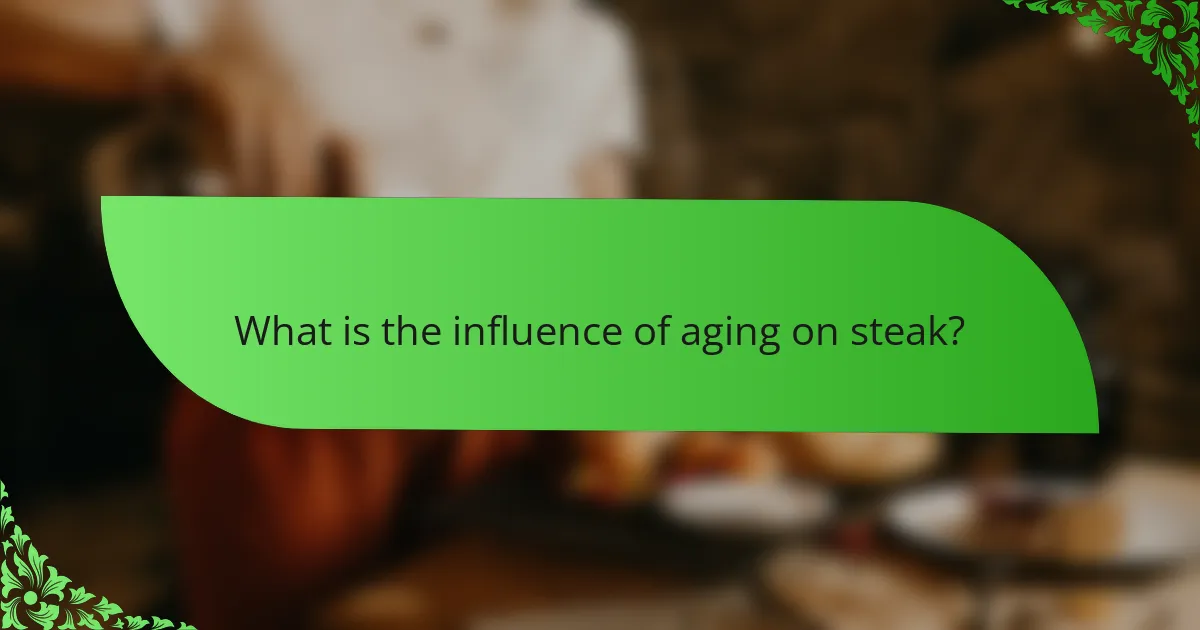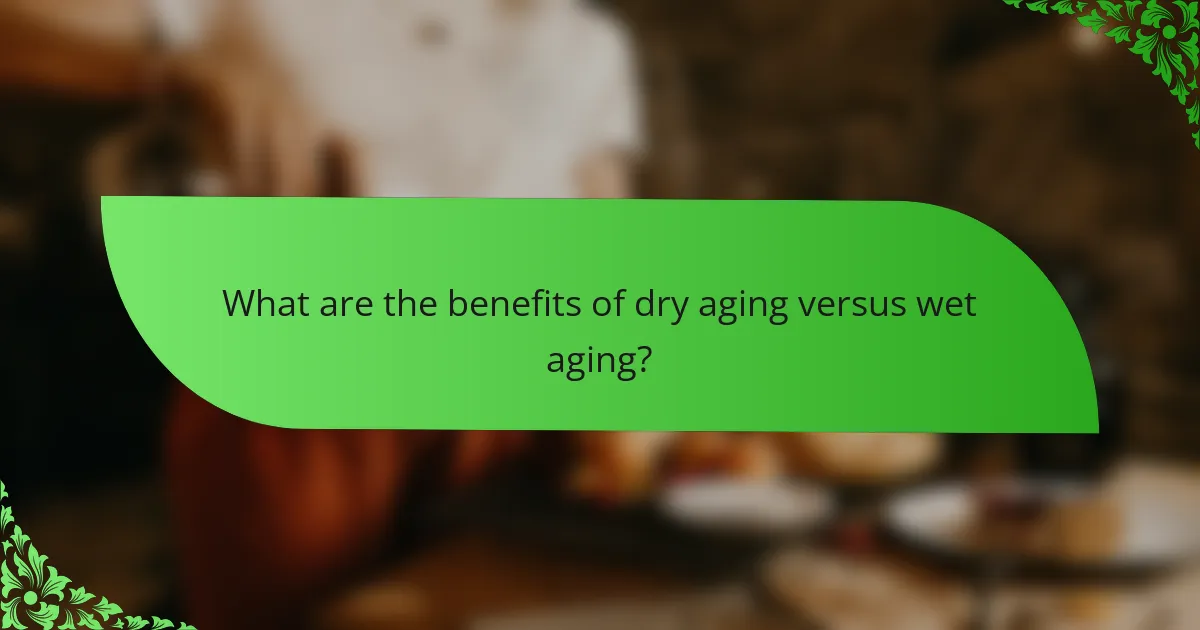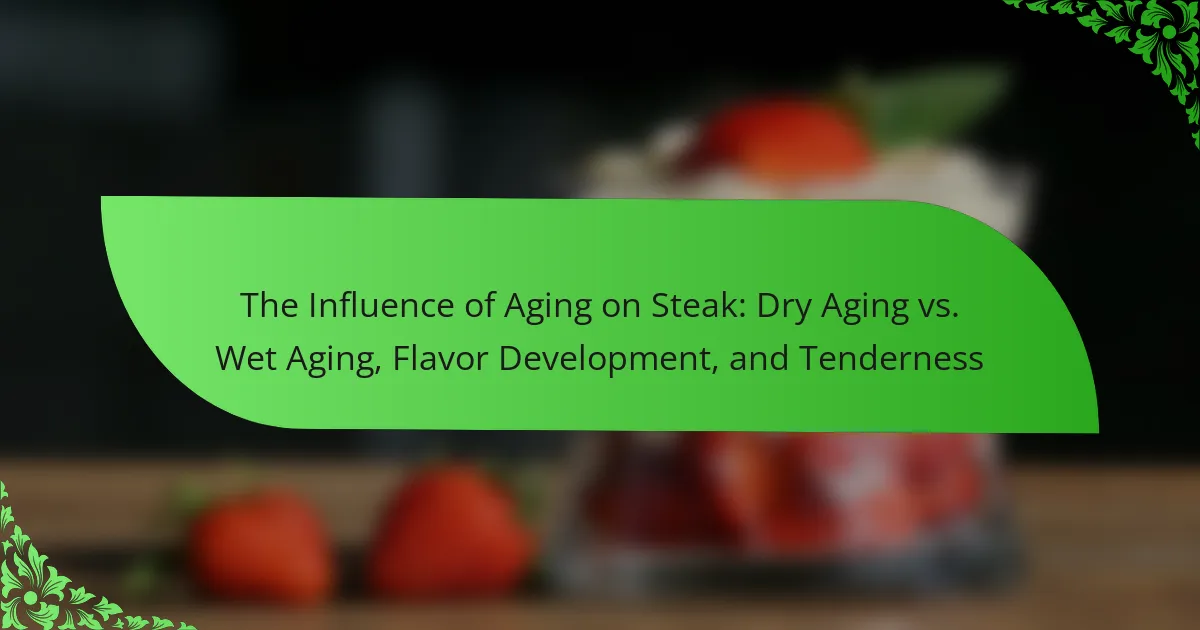Aging is a crucial process that significantly affects steak, particularly in terms of flavor and tenderness. The two primary methods of aging are dry aging and wet aging, each producing distinct results. Dry aging enhances flavor concentration and tenderness through moisture loss and the action of beneficial bacteria, while wet aging retains moisture, leading to a milder taste. Research shows that dry-aged steak can be up to 30% more tender than wet-aged steak. This article will explore the differences between these aging methods, their impact on flavor development, and practical tips for aging steak at home for optimal results.

What is the influence of aging on steak?
Aging significantly influences steak by enhancing its flavor and tenderness. During the aging process, enzymes break down muscle fibers, resulting in a more tender texture. This occurs in both dry aging and wet aging methods. Dry aging typically develops a concentrated, nutty flavor due to moisture loss and the growth of specific bacteria. Wet aging, on the other hand, retains moisture, leading to a milder flavor profile. Studies indicate that dry-aged steak can be up to 30% more tender than its wet-aged counterpart. The duration of aging also plays a crucial role; longer aging periods generally yield more pronounced flavor changes.
How do dry aging and wet aging differ in their processes?
Dry aging and wet aging differ significantly in their processes. Dry aging involves hanging beef in a controlled, chilled environment with low humidity. This process allows moisture to evaporate, concentrating flavors and enhancing tenderness. The exposure to air promotes the growth of beneficial mold, which further develops flavor.
In contrast, wet aging occurs when beef is vacuum-sealed in plastic and stored under refrigeration. This method retains moisture, resulting in a juicier product but less concentrated flavor. The natural enzymes in the meat break down connective tissues, leading to tenderness over time.
Dry aging typically requires several weeks, while wet aging can take as little as a few days. The flavor profiles also differ; dry-aged beef has a nutty, robust taste, while wet-aged beef tends to have a milder flavor. These distinct processes yield different culinary experiences for steak lovers.
What are the key steps involved in dry aging steak?
The key steps involved in dry aging steak include selecting the right cut, controlling the environment, and monitoring the aging process. First, select high-quality cuts, typically from the rib or loin section. Next, control the environment by maintaining a consistent temperature between 34°F and 38°F. Humidity levels should be around 80% to prevent spoilage. Place the steak on a rack to allow air circulation. The aging process usually lasts from 14 to 60 days, depending on desired flavor and tenderness. Regularly check for any off odors or mold. After aging, trim off the outer layer before cooking. This process enhances flavor and tenderness significantly.
What are the key steps involved in wet aging steak?
The key steps involved in wet aging steak include selecting high-quality cuts of meat, vacuum sealing the steak, and storing it in a controlled refrigerator. The steak should be kept at a temperature between 34°F and 38°F. It is typically aged for a period of 7 to 28 days. During this time, natural enzymes break down muscle fibers, enhancing tenderness. After aging, the steak is removed from the vacuum seal and prepared for cooking. This process retains moisture, resulting in a juicy final product. Wet aging can improve flavor without the risk of drying out the meat.
Why is aging important for steak flavor development?
Aging is important for steak flavor development because it enhances the meat’s taste and tenderness. During aging, enzymes break down muscle fibers and connective tissues. This process leads to increased tenderness. Additionally, flavor compounds develop as fat oxidizes and amino acids break down. Dry aging typically results in a more concentrated flavor compared to wet aging. According to research by the USDA, dry-aged beef can have a nutty and robust flavor profile. The aging process can last from a few weeks to several months, significantly impacting the final taste.
How does aging affect the flavor profile of steak?
Aging enhances the flavor profile of steak by intensifying its taste and tenderness. This process occurs through enzymatic breakdown of muscle fibers and connective tissues. During aging, moisture evaporates, concentrating the flavors. Dry aging typically develops a nuttier, more complex flavor. In contrast, wet aging retains more moisture, resulting in a milder, beefier taste. Studies show that dry-aged steak can have a flavor intensity increase of up to 30%. Aging also allows for the development of umami compounds, adding depth to the flavor. Ultimately, the method of aging significantly influences the overall sensory experience of steak.
What chemical changes occur in steak during the aging process?
During the aging process, steak undergoes several chemical changes. Proteins in the meat break down into smaller peptides and amino acids. This process enhances tenderness. Enzymatic activity increases, leading to flavor development. The natural enzymes, such as calpains and cathepsins, contribute to this breakdown. Additionally, the pH level of the meat decreases, which affects flavor and color. Moisture loss occurs, concentrating flavors and improving texture. These changes are crucial for the overall quality of aged steak.
What role does aging play in steak tenderness?
Aging plays a significant role in enhancing steak tenderness. During aging, enzymes break down muscle fibers and connective tissues. This process results in a more tender texture. Dry aging typically allows for more moisture loss, concentrating flavors and improving tenderness. Wet aging, on the other hand, retains moisture but still promotes enzymatic activity. Studies show that dry-aged beef can be up to 30% more tender than its wet-aged counterparts. The aging process can last from a few days to several weeks, impacting the final tenderness. Overall, aging is crucial for improving the eating experience of steak.
How does dry aging contribute to steak tenderness?
Dry aging significantly enhances steak tenderness. During the dry aging process, enzymes break down muscle fibers. This enzymatic activity leads to a more tender texture. Additionally, moisture loss concentrates the beef’s flavor. The aging process typically lasts from 14 to 60 days. Studies show that dry-aged beef can be up to 20% more tender than non-aged cuts. This increased tenderness is a result of both enzymatic breakdown and moisture evaporation. The combination of these factors creates a superior eating experience.
How does wet aging impact the tenderness of steak?
Wet aging significantly enhances the tenderness of steak. This process involves vacuum-sealing meat and allowing it to age in its own juices. During wet aging, natural enzymes break down muscle fibers, resulting in a more tender texture. Studies indicate that wet-aged steaks can be 10-20% more tender than their non-aged counterparts. The moisture retention in wet aging also prevents the loss of juiciness, contributing to an overall improved mouthfeel. This method typically lasts from a few days up to several weeks, depending on the desired outcome.

What are the benefits of dry aging versus wet aging?
Dry aging enhances flavor and tenderness compared to wet aging. Dry aging allows moisture evaporation, concentrating the beef’s flavor. This process also promotes the growth of beneficial mold and enzymes, which tenderize the meat. In contrast, wet aging retains moisture, resulting in a milder flavor profile. Wet aging typically occurs in vacuum-sealed bags, preventing moisture loss. Research indicates that dry-aged beef can have a more complex flavor, often described as nutty or earthy. A study by the American Meat Science Association found that dry-aged steaks scored higher in flavor and tenderness in taste tests. These factors make dry aging a preferred method for many chefs and steak enthusiasts.
How does each method enhance flavor differently?
Dry aging enhances flavor through moisture loss and enzymatic activity. This process concentrates the beef’s natural flavors. It develops nutty and earthy notes over time. The enzymatic breakdown of proteins creates a tender texture. Wet aging, on the other hand, retains moisture and results in a milder flavor. It primarily enhances the beef’s juiciness. The vacuum-sealed environment allows for minimal flavor development compared to dry aging. Both methods yield distinct taste profiles, appealing to different preferences. Dry aging is often favored for its complex flavors, while wet aging is preferred for its tenderness and juiciness.
What flavor characteristics are unique to dry-aged steak?
Dry-aged steak has unique flavor characteristics that include a concentrated, nutty taste and enhanced umami. The aging process allows enzymes to break down muscle fibers, resulting in improved tenderness. Additionally, dry aging promotes the development of complex flavors through moisture loss and oxidation. This process can lead to a more intense beef flavor compared to non-aged steak. Studies show that dry-aging can enhance flavors significantly, with some tasters noting notes of blue cheese and caramel. The unique characteristics arise from specific microbial activity during aging, which contributes to the distinctive aroma and flavor profile.
What flavor characteristics are unique to wet-aged steak?
Wet-aged steak is characterized by a more subtle, milder flavor profile compared to dry-aged steak. This is due to the moisture retained during the aging process. The wet aging process allows the meat to develop a tender texture while preserving its natural juices. The flavor is often described as fresh and clean. Additionally, wet-aged steak can have a slightly metallic taste due to the vacuum-sealing process. This method typically results in a less intense umami flavor than dry aging. Overall, the unique flavor characteristics of wet-aged steak include mildness, freshness, and a tender texture.
How do the methods affect the overall quality of the steak?
The methods of aging steak significantly affect its overall quality. Dry aging enhances flavor through moisture evaporation and enzymatic breakdown. This process concentrates the meat’s flavor and improves tenderness. Wet aging, on the other hand, retains moisture and results in a milder flavor profile. It primarily tenderizes the meat through natural enzymes without the flavor concentration seen in dry aging. Research shows that dry-aged steaks can have a flavor intensity increase of up to 30%. In contrast, wet-aged steaks often have a juicier texture but less pronounced taste. Thus, the choice of aging method directly influences both the flavor and tenderness of the steak.
What are the visual differences between dry-aged and wet-aged steak?
Dry-aged steak typically has a darker, more concentrated color compared to wet-aged steak. The exterior of dry-aged steak often appears crusty or leathery due to moisture loss during the aging process. In contrast, wet-aged steak retains a brighter, red color and a slick surface because it is vacuum-sealed, preventing moisture loss. Dry-aged steak may also show a more pronounced marbling, as fat can become more visible against the darker meat. Wet-aged steak generally has a smoother texture and a more uniform appearance. These visual differences stem from the distinct aging environments and processes used for each method.
How do consumers perceive the quality of dry-aged versus wet-aged steak?
Consumers generally perceive dry-aged steak as superior in quality compared to wet-aged steak. This perception is primarily due to the enhanced flavor and tenderness associated with the dry-aging process. Dry-aged steak undergoes moisture evaporation, concentrating its flavor and resulting in a nuttier, beefier taste. In contrast, wet-aged steak retains moisture, leading to a milder flavor profile. Research indicates that 70% of consumers prefer the taste of dry-aged steak over wet-aged options. Additionally, the texture of dry-aged steak is often described as more tender, which aligns with consumer preferences for a more enjoyable eating experience.

What are best practices for aging steak at home?
To age steak at home effectively, select high-quality cuts like ribeye or sirloin. Dry aging is recommended for enhanced flavor and tenderness. Use a dedicated refrigerator with controlled temperature and humidity, ideally around 34-38°F and 80-85% humidity. Ensure proper air circulation by placing the steak on a wire rack. Avoid wrapping the steak in plastic, as it can trap moisture and promote spoilage. Maintain cleanliness to prevent contamination. Aging should last from 7 to 21 days, depending on desired flavor intensity. After aging, trim any dry or hardened exterior before cooking. These practices align with culinary standards for optimal aging results.
How can you effectively dry age steak at home?
To effectively dry age steak at home, you need to control temperature, humidity, and airflow. Use a dedicated refrigerator that can maintain a consistent temperature between 34°F to 38°F. Ensure humidity levels are around 80% to prevent excessive moisture loss. Place a small fan inside the fridge to improve airflow around the meat. Wrap the steak in a breathable material, like cheesecloth, to protect it while allowing moisture to escape. Dry aging typically requires 21 to 45 days for optimal flavor and tenderness development. The process enhances the steak’s flavor through enzymatic breakdown of muscle fibers and concentration of natural juices.
What equipment is necessary for home dry aging?
The necessary equipment for home dry aging includes a dedicated refrigerator, a digital hygrometer, and a fan. A dedicated refrigerator maintains a consistent temperature between 34°F and 38°F. This temperature range is crucial for the aging process. A digital hygrometer measures humidity levels, ideally between 80% and 85%. Proper humidity prevents spoilage while allowing moisture loss. A fan circulates air within the refrigerator, promoting even drying of the meat. Additionally, a meat rack or wire rack is needed to elevate the meat, ensuring airflow around it. Using these tools creates an optimal environment for dry aging, enhancing flavor and tenderness.
What are common mistakes to avoid when dry aging steak at home?
Common mistakes to avoid when dry aging steak at home include using the wrong cut of meat. Not all cuts are suitable for dry aging. The best options are bone-in ribeye or strip loin. Another mistake is inadequate temperature control. The ideal temperature for dry aging is between 34°F and 38°F. Failing to maintain proper humidity is also a common error. Humidity levels should be around 80% to prevent spoilage. Additionally, using improper airflow can hinder the aging process. Air circulation is crucial for even drying. Lastly, neglecting sanitation can lead to contamination. Always ensure surfaces and tools are clean before starting the process.
What tips exist for wet aging steak at home?
To wet age steak at home, use vacuum-sealed bags to prevent exposure to air. Ensure the steak is fresh and of high quality. Store the sealed steak in the refrigerator at a consistent temperature of 32°F to 36°F. Keep the steak in the coldest part of the fridge, away from other foods. Allow the steak to age for 7 to 28 days for optimal flavor and tenderness. Check for any signs of spoilage, such as off odors or discoloration. After aging, cook the steak to enhance its flavor and tenderness. These practices help achieve the desired results of wet aging.
How can you ensure optimal conditions for wet aging steak?
To ensure optimal conditions for wet aging steak, maintain a consistent temperature of 34°F to 38°F. This temperature range prevents spoilage and promotes enzymatic breakdown of muscle fibers. Use vacuum-sealed bags to minimize exposure to air and bacteria. Vacuum sealing also helps retain moisture, enhancing tenderness. Store the steak in a dedicated refrigerator to avoid cross-contamination. Monitor humidity levels, ideally around 85%, to prevent drying out. Aging for a minimum of 14 days can enhance flavor and tenderness significantly. Research indicates that wet aging can improve steak quality by allowing natural enzymes to tenderize the meat.
What are the signs of spoiled wet-aged steak?
Signs of spoiled wet-aged steak include an off or sour smell. Fresh steak should have a mild, meaty aroma. A sticky or slimy texture indicates spoilage. The color may change to a dull brown or gray, which is not typical for fresh steak. Additionally, if the steak has visible mold, it is spoiled. Any unusual odor or texture should be taken seriously. Proper storage and handling can prevent spoilage. Always check for these signs before cooking or consuming wet-aged steak.
What practical advice can enhance your steak aging experience?
To enhance your steak aging experience, select high-quality cuts of meat. Choose cuts with good marbling, as fat contributes to flavor during aging. Maintain a controlled environment with proper humidity and temperature. Ideal conditions for dry aging are around 34-38°F and 80-85% humidity. Use a dedicated aging fridge or a cooler with precise temperature control. Regularly check for any off-odors or mold growth. Trim excess outer layers before cooking to improve taste. Aging time can vary; typically, 21 to 45 days is recommended for optimal flavor development. Research shows that aging increases tenderness and enhances flavor compounds in beef.
The primary entity of this article is steak, with a focus on the influence of aging methods—dry aging and wet aging—on its flavor development and tenderness. The article examines how aging enhances steak by breaking down muscle fibers through enzymatic activity, resulting in increased tenderness and distinct flavor profiles. It details the processes of dry aging and wet aging, highlighting their differences in flavor concentration and moisture retention, as well as the specific steps and best practices for aging steak at home. Additionally, it discusses the chemical changes that occur during aging and the visual and sensory differences perceived by consumers.
